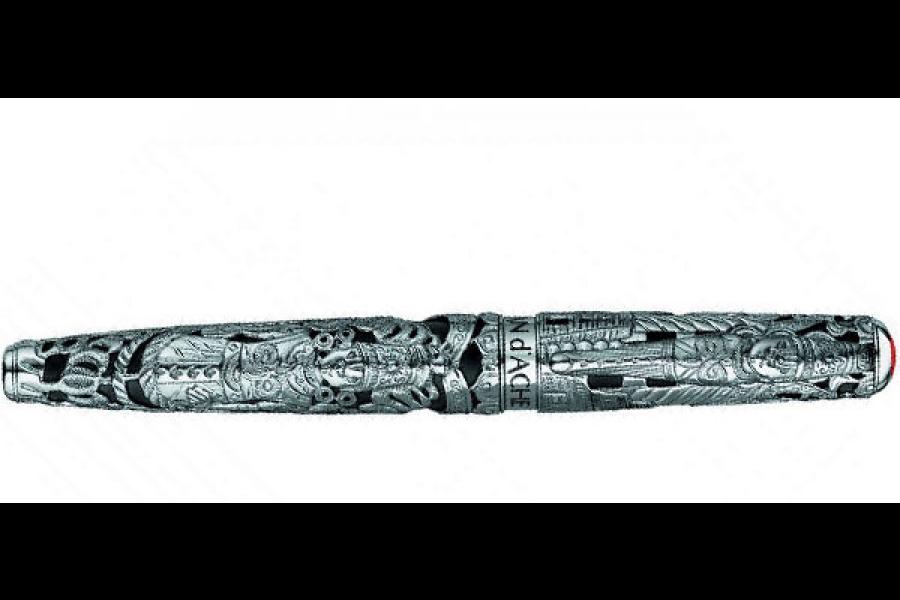
India-Made Fountain Pens Thrive On Global Demand
Steeped in history and tradition, Indian-made fountain pens—despite their relative anonymity—are thriving on global demand
A felt-lined tray is placed on the counter separating me from the gleaming shrines at the William Penn boutique store at High Street Phoenix Mall in Lower Parel, Mumbai. Slipping on a dark glove, the high priestess approaches a glass-enclosed shrine and turns the key. From a distance, you are already in awe of the fine craftsmanship of Japanese Maki-e artiste Kousen Oshita in creating this exquisite tribute to Lord Venkateswara. As the glass veil parts, the priestess delicately lifts the object of worship from its pedestal and rests it on a velvet bed.
Yes, this is a sacred ritual.
Darshan (viewing) becomes anubhava (experience) as my fingers curl around the barrel of the Sri Venkateswara Fountain Pen. I am finally holding No. 101 of the 108 limited edition pens from Sailor, one of the world’s most respected pen manufacturers and designed by a Japanese master craftsman, commissioned exclusively for Indian connoisseurs. The first sensation is that of a snug, smooth warmth of the urushi-lacquered body. Cradled between the fingers, my attention is drawn to the understated yet distinguished naamam mark inscribed on the 21K gold nib. The heft is just right. As I hesitantly ‘air-write’, the balance is poised, and the sway, rhythmic. When I gather the courage to scribble on a pad, Sri Venkateswara delivers on that cherished covenant between a man and his pen—ink flowing in perfect sync with the thought.
In neighbouring shrines, Caran d’Ache’s limited edition fountain pens—the Shiva and the Balaji—and Noblia’s Indian special, the Ganesh, shine benevolently amidst globally revered writing instruments like the Sheaffer Legacy Heritage, Visconti Ripple Black and Montblanc’s Jonathan Swift Platinum Trims.
It serves as a reminder. The world’s leading brands of luxury writing instruments are aggressively vying for the attention of Indian pen aficionados. However, Indian makers like Ratnam, Guider or Deccan (admired by fountain pen connoisseurs globally) are conspicuously missing from the boutiques that have sprung up across Indian metros.
A close encounter with Indian fountain pen royalty demands a hike outside the comfort zone of plush malls and air-conditioned outlets. One such pilgrimage takes me to the small town of Rajahmundry in Andhra Pradesh. Wandering in the narrow, nondescript lanes of the Fort Gate Street area, I find myself in front of a board reading, “Pioneers of Pen Industry in India since 1932. K.V. Ratnam & Sons, Ratnam Ball Pen Works, Mfrs: Swadeshi ‘Ratnamson’ pens, 14 ct-Gold Nib.” This humble workshop is where ‘Swadeshi Ratnamson’, the first Indian-made fountain pen, was born.
A frame on a wall contains a note dated July 16, 1935. The paper has yellowed with age, the hand is uneven. “Dear Ratnam, I must thank you for the fountain pen you sent me... I have needed it and seems to be a good substitute to the foreign pen, one sees in the bazaar.” It is signed MK Gandhi, an endorsement from the Mahatma himself, written in response to Ratnam’s gift of one of his first creations—a pen that was symbolic of India’s fight for freedom—by an Indian, for an Indian and of an Indian. Eighty years later, both the Ratnam establishments (run by KV Ratnam’s two sons) lining the narrow lane proudly display copies of this iconic letter.
At Ratnam Ball Pen Works shop, another ritual begins—this one, more basic, organic. As the contemporary range of Ratnam pens is laid out for me, I notice the stark contrast in presentation. No fancy lights or frills, just a purity of shared passion as he explains the salient features. The handmade ebonite designs are characterised by their zen-like simplicity. The appeal of these pens lies in the experience of owning a small piece of heritage. Ebonite, a form of hardened rubber, was among the first materials used to craft mass-produced fountain pens. These pens are remarkable for their carbon black or mottled appearance. The simplicity of the exterior is complemented perfectly by the precision of its operation.
In a telephone conversation, Ramanamurthy (one of Ratnam’s sons) has this to share: “My father Kosuri Venkat Ratnam met Gandhiji in 1921. It was Gandhiji who asked him to create a product that could be used by Indians. Inspired by this request, my father created the Swadeshi Ratnamson pen as his contribution to Mahatma Gandhi’s Swadeshi movement.”
Murthy recounts the historical figures that have since patronised handmade ebonite pens from Ratnam. “One of the very first pens was bought by N Subba Rao Pantulu and S Kasturi Ranga Iyengar, the founders/managers of what is now The Hindu Group. Our list of patrons also included the maharajas of Mysore, Jaipur and Vijayanagar. Jawaharlal Nehru made a special trip to our shop to buy a Ratnamson on his visit to Rajahmundry. Leaders like Rajendra Prasad, VV Giri and Indira Gandhi and Indian Express founder Ramnath Goenka were also Ratnamson loyalists,” he says, with a smile in his voice. “Internationally, Ratnam owners include US President Eisenhower, German chancellors Arbhalnon and Thomson and Russian President Khrushchev.”
With fountain pens being the preferred writing instrument for the discerning, Ratnam Pen Works is basking in renewed attention thanks to the very source that was once considered the death knell for fountain pens—computers and the internet. Online forums dedicated to fountain pens have spread the word about Ratnam Ball Pen Works. “We get most of our orders online—not just from Indian collectors but also from New Zealand, Australia, the US, Japan and Germany. Each pen is handcrafted to meet the specifications requested by the buyer,” says Murthy.
The most basic Ratnam pens are priced between Rs 100 and Rs 5,000. These are handcrafted in two days and delivered in a week. Ratnam also calls upon its jeweller roots to create pens in sterling silver and 14K gold on order. The sterling silver pens with gold nibs take a fortnight to make and cost between Rs 2,500 and Rs 15,000. A pure gold pen takes a month to produce and costs over Rs 2 lakh.
Ratnam’s legacy is not limited to the Swadeshi Ratnamson. The pioneering penmakers are also the inspiration behind Guider Pen Works, another Rajahmundry institution, located a short distance away. Established in 1946 by G Subbarao, under the guidance of KV Ratnam, Guider too shares the legacy of aristocrats, politicians and royalty as patrons.
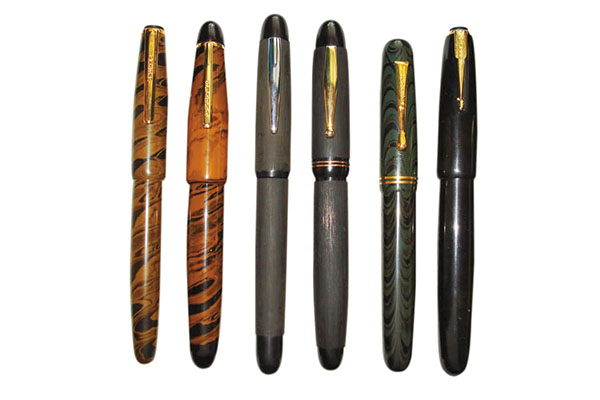
A few hundred kilometres to the south, in the state capital of Hyderabad, I am at that other Mecca of fountain pen lovers for another tryst with fountain pen divinity—the Deccan Pen Store in Abids, a historic shopping district. Mustafa, one of the seven brothers who manage the group of pen stores, shares the history of Deccan pens. “My father SS Siddiqui went to Calcutta in the 1920s and became an agent for two European pen manufacturers—Conway Stewart of England and Duro Pens of France. Osmania University had just been established [in 1918] and realising the potential customer base, my father arrived in Hyderabad with a bag of European pens. Initially, there was no shop. He sold the pens as a roaming salesman. This shop was set up in 1928,” he says.
The shop wears its heritage with pride. Old black-and-white advertisements and photographs dot the walls. His voice brightens as he recounts a favourite anecdote. “In 1932, we hired our first English-speaking salesman. He had to be brought in all the way from Bombay as locals only knew Hindi and Urdu but our main clientele was British. So, it was necessary that we have an English-speaking salesman,” he adds with a laugh.
Siddiqui started designing pens under the Deccan brand in the late 1950s. These designs would be sent to Europe for manufacturing. “To this day, we only make fountain pens. The true joy of writing can be only experienced when you write with a fountain pen,” Mustafa says with a hint of snobbery. Deccan now has its own manufacturing unit and, like Ratnam, it is also thriving on a global demand facilitated by internet forums.
However, Deccan has another specialisation that has made it a go-to name among fountain pen collectors—service and repair of vintage pens. “It has emerged as the most critical side of our business,” Mustafa says. The pen repair and servicing tools and equipment that Siddiqui brought back from his travels to Europe in the 1930s have grown into invaluable assets.
The Abids shop that houses the section receives pens worth lakhs of rupees for repairs and servicing from all over the world. Peeking into the servicing section, I see craftsmen engrossed in restoring an early 20th century pen to its glory.
Beyond the gloss of the display cases, in this dusty workshop, worship transcends the superficiality of awe and admiration, slick salesmanship and superficial gimmicks. Gods are not inscribed on these pens. Here the pens themselves are gods.
Fountains of Bling
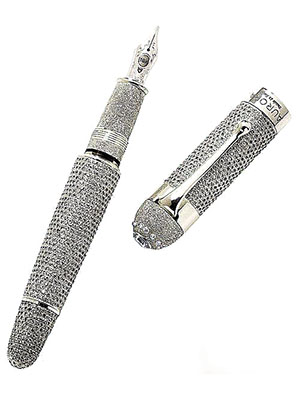
Aurora Diamante
If you are going to own a pen worth one-and-a-half million dollars, it better look like it. The Aurora Diamante Fountain Pen is the only pen in the world to carry over 30 carats of De Beers certified sparklers on a platinum barrel, with a rhodium-plated, 18K gold nib. This Italian luxury design house merges refined craftsmanship with technology to create just one Diamante fountain pen every year.
Price: $1,470,000
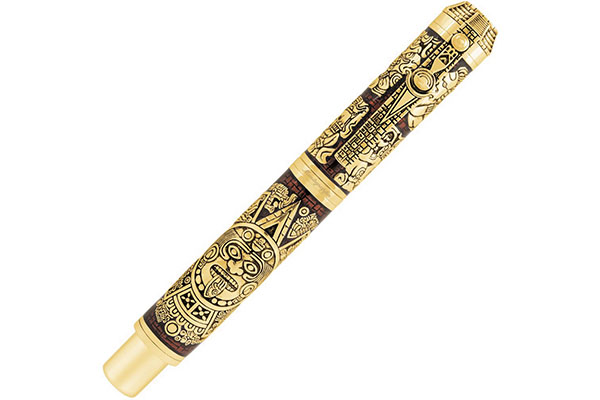
Launched in 2012 to commemorate the end of the Mayan calendar, the Mayan Calendar Gold fountain pen from Montegrapa is dedicated to Mexico’s civilisations. The limited edition (20 pieces only) solid 18K gold pen is decorated with hand-etched images of Mexican gods and glyphs, and patterns borrowed from Mayan architecture. The clip is designed like a sacrificial sword used by ancient Mayan priests.
Price: $133,458
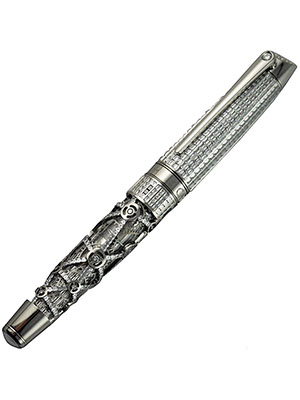
Caran d’Ache 1010 Diamonds Limited Edition
Legendary pen makers Caran d’Ache transforms the writing instrument into a piece of haute jewellery, with its 1010 Diamonds Limited Edition fountain pen. The ‘1010’ stands for 10 minutes past 10 on a dial, when the hands are in perfect equilibrium. The white gold body is studded with 850 diamonds (24.61 carats) in a design inspired by watches with skeletonised case backs.
Price: $1,000,000
(This story appears in the 18 October, 2013 issue of Forbes India. To visit our Archives, click here.)
-
 Suresh Enjeti
Suresh EnjetiCould you please send me the address and /or e-mail of Ratnam pens? I need to contact them regarding some work to be done on a custom pen they made for me.
on Oct 25, 2014 -
 Yeldtho
YeldthoHi! It was an interesting reading. There is an error though. In the text reproduced from Gandhiji\'s letter, you wrote (I see the same error made by many) ..\"I have needed it..\" The actual words were, \"I have used it..\" Any way thanks for the article. Eldtho Mathew
on Oct 13, 2013 -
 Satyanandan
SatyanandanTake your pick. Lavish opulence or elegant simplicity ?
on Oct 10, 2013
